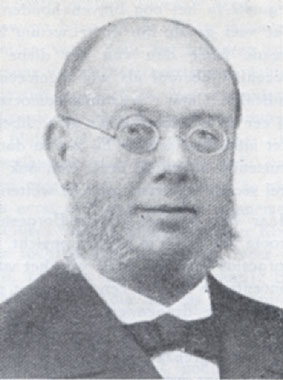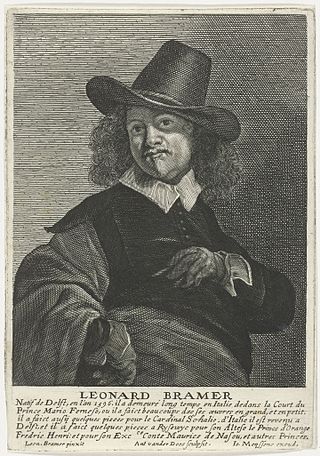
Delft is a city and municipality in the province of South Holland, Netherlands. It is located between Rotterdam, to the southeast, and The Hague, to the northwest. Together with them, it is a part of both the Rotterdam–The Hague metropolitan area and the Randstad.

Eduard Douwes Dekker, better known by his pen name Multatuli, was a Dutch writer best known for his satirical novel Max Havelaar (1860), which denounced the abuses of colonialism in the Dutch East Indies. He is considered one of the Netherlands' greatest authors.

Everhardus Johannes Potgieter was a Dutch prose writer and poet, who was born at Zwolle in Overijssel.

Wander Johannes de Haas was a Dutch physicist and mathematician. He is best known for the Shubnikov–de Haas effect, the De Haas–Van Alphen effect and the Einstein–de Haas effect.

Nicolaas Gerard Pierson was a Dutch economist and Liberal statesman who served as the chairman of the Council of Ministers of the Netherlands from 1897 until 1901.

Amsterdam Impressionism was an art movement in late 19th-century Holland. It is associated especially with George Hendrik Breitner and is also known as the School of Allebé.

Leonaert Bramer, also Leendert or Leonard, was a Dutch painter known primarily for genre, religious, and history paintings. Very prolific as a painter and draftsman, he is noted especially for nocturnal scenes which show a penchant for exotic details of costume and setting. He also painted frescos—a rarity north of the Alps—which have not survived, as well as murals on canvas, few of which are extant. Bramer is one of the most intriguing personalities in seventeenth-century Dutch art.

Jacob de Witt, heer van Manezee, Melissant and Comstryen was a burgomaster of Dordrecht and the son of a timber merchant. De Witt was an influential member of the Dutch States Party, and was in opposition to the House of Orange. He was also a younger brother of Andries de Witt and the father of Johan and Cornelis de Witt.
De Bruyn is a Dutch and Afrikaans surname. "Bruyn" or "bruijn" is an archaic spelling of "bruin", meaning "brown". People with the name include:

View of Delft is an oil painting by Johannes Vermeer, painted c. 1659–1661. The painting of the Dutch artist's hometown is among his best known. It is one of three known paintings of Delft by Vermeer, along with The Little Street and the lost painting House Standing in Delft, and his only cityscape. According to art historian Emma Barker, cityscapes across water, which were popular in the Netherlands at the time, celebrated the city and its trade. Vermeer's View of Delft has been held in the Dutch Royal Cabinet of Paintings at the Mauritshuis in The Hague since its establishment in 1822.

Agneta Wilhelmina Johanna van Marken-Matthes was a Dutch entrepreneur. She and her husband Jacques van Marken were involved in the manufacture of yeast throughout their lives, and were engaged in the co-operative movement, taking care of their workers. Matthes and Van Marken created living quarters for workers in her hometown, Delft in South Holland, named Agnetapark after her. These are considered a model for the co-operative development and construction of garden cities for workers. Matthes founded and ran a Delft perfume factory, Maison Neuve, to take advantage of a by-product from the yeast factory.

Henri Alexander Elias was a Dutch colonial administrator, who served as governor of the Dutch Gold Coast.

Jan van Londerseel was a Flemish draughtsman, engraver, etcher and print maker. After training and working in Antwerp he was active in the Dutch Republic during the latter part of his career.

Jan Gildemeester Jansz. was a Dutch art collector.
The following is a timeline of the history of the municipality of Delft, Netherlands.

Estella Dorothea Salomea Hijmans-Hertzveld was a Dutch poet, translator, and activist. From a young age, her poems, mainly on Biblical and historical themes, appeared regularly in respectable literary journals. Frequently, her work also addressed contemporary social issues, including the abolition of slavery, Jewish emancipation, and opposition to war. A collection of her best-known poems, entitled Gedichten ('Poems'), was published several weeks before her death in 1881.
Jeanne Maria Cornelia de Loos-Haaxman was a Dutch art historian and writer.
Jacob van den Eynde was a Dutch statesman, Pensionary of the Brugse Vrije, Pensionary of Delft, and Grand Pensionary of Holland.
Hugo van den Eynde was a Dutch statesman, and Pensionary of Delft. He was succeeded in this position by his son Jacob van den Eynde.
Alkmaar was an electoral district of the House of Representatives in the Netherlands from 1848 to 1918.














